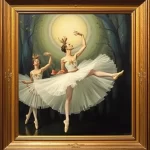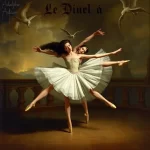Ballet: Le Festin de l’araignée (Albert Roussel, 1913)

Introduction
Ballet, a classical dance form known for its grace and precision, has produced numerous masterpieces over the centuries. One such gem is “Le Festin de l’araignée” (The Spider’s Feast), a ballet composed by Albert Roussel in 1913. This ballet, choreographed by Léo Staats, premiered on April 3, 1913, at the Théâtre des Arts in Paris. The ballet’s plot revolves around the life and death struggles within a garden, focusing on the interactions between insects and a spider, creating a microcosm of nature’s drama.
Historical Background
Creation and Development
“Le Festin de l’araignée” was created during a period of significant artistic innovation in Europe. The early 20th century saw a surge in interest in nature and the natural world, influenced by the Art Nouveau movement and a growing fascination with the intricacies of life. Albert Roussel, inspired by the delicate balance of life and death in nature, sought to capture this in his composition. The ballet’s narrative was influenced by literary sources and folklore that depicted the natural world’s beauty and brutality.
The collaboration between Roussel and choreographer Léo Staats was crucial in bringing this vision to life. Staats, a prominent figure in the Parisian ballet scene, was known for his ability to translate complex musical compositions into expressive dance movements. Together, they created a ballet that was both visually and musically captivating.
Premiere and Reception
“Le Festin de l’araignée” premiered on April 3, 1913, at the Théâtre des Arts in Paris. The initial reception was mixed, with some critics praising the innovative score and choreography, while others found the subject matter unusual for a ballet. Despite this, the ballet quickly gained popularity, with notable early performances and revivals solidifying its place in the ballet repertoire.
Synopsis of the Ballet
“Le Festin de l’araignée” is a one-act ballet that unfolds in a garden, where various insects go about their daily lives, unaware of the lurking danger posed by a spider. The ballet is divided into several key scenes, each depicting different aspects of the garden’s ecosystem.
Key Moments
- The Garden Awakens: The ballet opens with the garden coming to life as insects emerge and begin their activities.
- The Spider’s Web: The spider weaves its web, setting the stage for the ensuing drama.
- The Dance of the Insects: Various insects, including ants, butterflies, and beetles, perform intricate dances, showcasing their unique characteristics.
- The Capture: The spider captures a butterfly in its web, highlighting the predatory nature of the garden.
- The Feast: The spider feasts on its prey, symbolizing the cycle of life and death.
- The Garden Sleeps: The ballet concludes with the garden returning to a state of calm, as the insects retreat and the spider rests.
Musical Composition
Composer’s Role
Albert Roussel, a French composer known for his unique blend of impressionism and neoclassicism, played a pivotal role in the creation of “Le Festin de l’araignée.” His score is characterized by its vivid orchestration and ability to evoke the natural world. Notable pieces within the score include the “Prelude,” which sets the scene for the garden, and the “Dance of the Ants,” a lively and rhythmic movement that captures the industrious nature of the insects.
Musical Themes and Motifs
Roussel’s composition is rich with recurring musical themes and motifs that enhance the narrative and emotional depth of the ballet. The use of leitmotifs, such as the delicate theme representing the butterfly and the ominous motif for the spider, helps to create a cohesive and immersive experience. The music’s dynamic range, from gentle melodies to dramatic crescendos, mirrors the ballet’s shifting moods and tensions.
Famous Recordings and Performances
Several iconic recordings of “Le Festin de l’araignée” have been made over the years, with notable performances by orchestras such as the Orchestre National de France and the London Symphony Orchestra. These recordings have helped to preserve and popularize Roussel’s masterful score, allowing new generations to appreciate its beauty.
Choreography and Dance
Choreographer’s Vision
Léo Staats, the choreographer of “Le Festin de l’araignée,” brought a unique vision to the ballet. His interpretation emphasized the naturalistic movements of the insects, blending classical ballet techniques with more contemporary, expressive styles. Staats’ choreography was innovative for its time, incorporating elements of mime and character dance to bring the garden’s inhabitants to life.
Signature Dance Numbers
Key dance numbers in the ballet include the “Dance of the Ants,” a synchronized and rhythmic performance that showcases the ants’ industrious nature, and the “Butterfly’s Solo,” a delicate and graceful dance that highlights the butterfly’s fragility. These dances not only reflect the characters’ traits but also advance the narrative, illustrating the interactions and conflicts within the garden.
Notable Interpretations
Over the years, various productions have interpreted “Le Festin de l’araignée” in different ways. Some have emphasized the ballet’s darker, more sinister aspects, while others have focused on its whimsical and enchanting qualities. These interpretations have kept the ballet fresh and relevant, allowing it to resonate with diverse audiences.
Characters and Roles
Main Characters
- The Spider: The central antagonist, representing predation and the cycle of life and death.
- The Butterfly: A symbol of beauty and fragility, whose capture by the spider is a pivotal moment in the ballet.
Supporting Characters
- The Ants: Representing industriousness and community, they perform a lively and rhythmic dance.
- The Beetles: Adding to the garden’s diversity, they contribute to the ballet’s rich tapestry of insect life.
Famous Dancers
Notable dancers who have portrayed these roles include Serge Lifar as the Spider and Yvette Chauviré as the Butterfly. Their performances have left a lasting impact on the ballet’s legacy.
Cultural and Artistic Impact
Influence on Ballet and Dance
“Le Festin de l’araignée” has influenced numerous choreographers and composers, inspiring them to explore themes of nature and the natural world in their works. Its innovative choreography and evocative score have contributed to the development of ballet as an art form, pushing the boundaries of what ballet can represent.
Cultural Significance
The ballet’s depiction of the natural world has resonated with audiences and artists alike, influencing literature, visual arts, and other media. Its themes of life, death, and the delicate balance of nature continue to be relevant in contemporary discussions about the environment and ecology.
Legacy and Revivals
“Le Festin de l’araignée” has seen numerous revivals and reinterpretations over the years, with modern adaptations bringing new perspectives to the ballet. Its enduring popularity is a testament to its artistic significance and the universal themes it explores.
Iconic Productions
Historic Productions
Historic productions of “Le Festin de l’araignée” have featured prominent figures such as Serge Lifar and Yvette Chauviré. These productions set the standard for future performances, with their innovative choreography and striking set designs.
Contemporary Productions
Recent productions have brought new interpretations to the ballet, incorporating modern dance techniques and contemporary set designs. These adaptations have kept the ballet relevant and accessible to new audiences.
Production Design
The set, costume, and lighting design in various productions of “Le Festin de l’araignée” have played a crucial role in bringing the garden to life. From intricate insect costumes to atmospheric lighting, these elements enhance the ballet’s visual and emotional impact.
Critical Reception and Reviews
Initial Critical Response
At the time of its premiere, “Le Festin de l’araignée” received mixed reviews. Some critics praised its innovative score and choreography, while others found the subject matter unusual for a ballet. Despite this, the ballet quickly gained popularity and critical acclaim.
Modern Reviews
Contemporary critics and audiences continue to appreciate “Le Festin de l’araignée” for its artistic innovation and emotional depth. Its themes of nature and the cycle of life and death remain relevant, making it a timeless piece in the ballet repertoire.
Fun Facts and Trivia
Behind-the-Scenes Stories
One interesting anecdote from the production of “Le Festin de l’araignée” involves the creation of the spider’s web. The intricate design required careful planning and execution, with the choreographer and set designers working closely to ensure it was both visually striking and functional for the dancers.
Notable Performers
Famous dancers associated with “Le Festin de l’araignée” include Serge Lifar, who brought a unique intensity to the role of the Spider, and Yvette Chauviré, whose delicate portrayal of the Butterfly captivated audiences.
Trivia
- The ballet’s score was one of Albert Roussel’s early successes, helping to establish his reputation as a composer.
- “Le Festin de l’araignée” was one of the first ballets to focus on the natural world, paving the way for future works with similar themes.
Conclusion
Summary of the Ballet’s Importance
“Le Festin de l’araignée” is a significant work in the world of ballet, known for its innovative choreography, evocative score, and exploration of nature’s delicate balance. Its themes of life, death, and the natural world continue to resonate with audiences, making it a timeless piece in the ballet repertoire.
Final Thoughts
Reflecting on “Le Festin de l’araignée,” it is clear that this ballet has left a lasting impact on the world of dance. Its unique blend of music, choreography, and storytelling creates an immersive experience that captivates audiences. For those who have not yet experienced this masterpiece, watching a performance or listening to the score is highly recommended.
FAQ
What is the central theme of this ballet?
The central theme of “Le Festin de l’araignée” is the delicate balance of life and death in the natural world, depicted through the interactions of insects in a garden.
Who are the main characters in this ballet?
The main characters are the Spider, representing predation and the cycle of life and death, and the Butterfly, symbolizing beauty and fragility.
What is the most famous dance number in this ballet?
One of the most famous dance numbers is the “Dance of the Ants,” known for its synchronized and rhythmic performance that showcases the ants’ industrious nature.
How long does a typical performance of this ballet last?
A typical performance of “Le Festin de l’araignée” lasts approximately 30 to 40 minutes, as it is a one-act ballet.
Are there any modern adaptations of this ballet?
Yes, there have been several modern adaptations of “Le Festin de l’araignée,” incorporating contemporary dance techniques and set designs to bring new perspectives to the ballet.
Why is this ballet considered important in the history of dance?
“Le Festin de l’araignée” is considered important for its innovative choreography, evocative score, and exploration of nature’s themes. It has influenced numerous choreographers and composers, contributing to the development of ballet as an art form.





